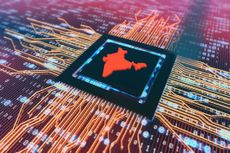Work Email Phishing Scams on the Rise: The Kiplinger Letter
Phishing scam emails continue to plague companies despite utilizing powerful email security tools.

To help you understand what is going on in the cyber security sector regarding phishing and other scams and what we expect to happen in the future, our highly experienced Kiplinger Letter team will keep you abreast of the latest developments and forecasts (Get a free issue of The Kiplinger Letter or subscribe). You'll get all the latest news first by subscribing, but we will publish many (but not all) of the forecasts a few days afterward online. Here’s the latest…
Despite companies utilizing powerful email security tools, phishing scams are still a growing risk. In fact, according to the Fortinet 2023 Global Ransomware Report, phishing is the top tactic (56%) that malicious actors use to access a network and launch ransomware effectively.
Hacked email accounts can be used to impersonate the owner and send a phishing message to all contacts. Phishing emails may also come with legitimate hyperlinks that redirect victims to a confusing series of pages, finally leading them to a page to steal their information.

Sign up for Kiplinger’s Free E-Newsletters
Profit and prosper with the best of expert advice on investing, taxes, retirement, personal finance and more - straight to your e-mail.
Profit and prosper with the best of expert advice - straight to your e-mail.
Another trend is tailored phishing emails that are chock-full of personalized details. Some advice businesses may want to consider might be pushing employees to report potential phishing threats to IT, which can help improve security tools. Video-based training is a good start, but individual training should focus on the specific threats of different job types.
In addition, one ransomware vulnerability businesses need to take seriously is employees’ personal devices and other unmonitored work devices. The vast majority of successful ransomware attacks start with unmanaged devices. Personal smartphones that are used for work can be one way an employee falls prey to a phishing attack — where a cybercriminal takes control of key data or systems and demands money to return things to normal. It’s a reminder that companies, even small ones, need to make sure that IT is managing devices and that workers are using basic defenses, such as strong passwords and two-factor authentication.
This forecast first appeared in The Kiplinger Letter, which has been running since 1923 and is a collection of concise weekly forecasts on business and economic trends, as well as what to expect from Washington, to help you understand what’s coming up to make the most of your investments and your money. Subscribe to The Kiplinger Letter.
Related Content

To continue reading this article
please register for free
This is different from signing in to your print subscription
Why am I seeing this? Find out more here
Get Kiplinger Today newsletter — free
Profit and prosper with the best of Kiplinger's advice on investing, taxes, retirement, personal finance and much more. Delivered daily. Enter your email in the box and click Sign Me Up.

John Miley is a Senior Associate Editor at The Kiplinger Letter. He mainly covers technology, telecom and education, but will jump on other important business topics as needed. In his role, he provides timely forecasts about emerging technologies, business trends and government regulations. He also edits stories for the weekly publication and has written and edited e-mail newsletters.
He joined Kiplinger in August 2010 as a reporter for Kiplinger's Personal Finance magazine, where he wrote stories, fact-checked articles and researched investing data. After two years at the magazine, he moved to the Letter, where he has been for the last decade. He holds a BA from Bates College and a master’s degree in magazine journalism from Northwestern University, where he specialized in business reporting. An avid runner and a former decathlete, he has written about fitness and competed in triathlons.
-
 Rent a Luxury Pool This Summer With Swimply — the Airbnb of Pools
Rent a Luxury Pool This Summer With Swimply — the Airbnb of PoolsWith Swimply, you can live it up at a luxury pool while escaping the heat and going for a swim.
By Erin Bendig Published
-
 The Secret Credit Card for Amazon Prime Day Shopping
The Secret Credit Card for Amazon Prime Day ShoppingThis "secret" credit card for Amazon Prime Day shopping can maximize your cash back rewards. Plus get a $300 bonus.
By Erin Bendig Published
-
 Congress Spends Big on Closing the Digital Divide
Congress Spends Big on Closing the Digital DivideThe Kiplinger Letter A massive spending program is designed to bring high-speed internet to rural and remote locations.
By John Miley Published
-
 Kiplinger Special: The Long-Term Future of the U.S. Economy
Kiplinger Special: The Long-Term Future of the U.S. EconomyThe Kiplinger Letter Kiplinger's report into what it will take the U.S. to maintain a healthy economic growth rate.
By David Payne Published
-
 The Fight Against Cancer Enters a New Phase
The Fight Against Cancer Enters a New PhaseThe Kiplinger Letter Breakthrough treatments hold promise for patients and investors.
By Matthew Housiaux Published
-
 After Decades of Promise, the Virtual Reality Era Has Finally Arrived
After Decades of Promise, the Virtual Reality Era Has Finally ArrivedThe Kiplinger Letter VR is a paradigm shift for consumer technology. The tech has a long road ahead, but amazing hardware already puts the huge potential on full display.
By John Miley Published
-
 AI to Power the Next Generation of Robots
AI to Power the Next Generation of RobotsThe Kiplinger Letter There's increasing buzz that the tech behind ChatGPT will make future industrial and humanoid robots far more capable.
By John Miley Published
-
 The Robots Are Coming... But Not For a While
The Robots Are Coming... But Not For a WhileThe Kiplinger Letter There’s excitement in the tech sector over the potential of humanoid robots, but widespread adoption is likely to be years away.
By John Miley Published
-
 Farmers Face Another Tough Year As Costs Continue to Climb: The Kiplinger Letter
Farmers Face Another Tough Year As Costs Continue to Climb: The Kiplinger LetterThe Kiplinger Letter Farm income is expected to decline for a second year, while costs continue to up-end farm profitability.
By Matthew Housiaux Published
-
 India's Semiconductor Sector Eyes Expansion Amid AI Chip Boom: The Kiplinger Letter
India's Semiconductor Sector Eyes Expansion Amid AI Chip Boom: The Kiplinger LetterThe Kiplinger Letter As Wall Street’s love affair with chip firms continues, a recent report highlights India’s plans to expand its semiconductor industry.
By John Miley Published